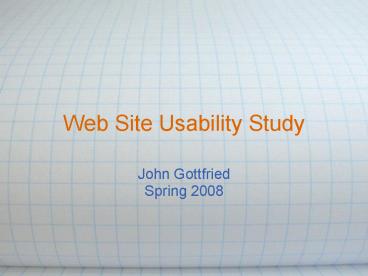Web Site Usability Study PowerPoint PPT Presentation
1 / 21
Title: Web Site Usability Study
1
Web Site Usability Study
- John Gottfried
- Spring 2008
2
By way of illustration
- There are really good Web sites
- And there are, well,
- other Web sites
3
Web Site Evaluation
- Compatibility Testing
- Interaction among components (browsers,
computers, operating systems, printers, etc.) - Security Testing
- Checks for unauthorized access to system
- Functional Testing
- Looks for broken features or functions
- Usability Testing
- Does the user find navigating the site difficult,
unpleasant or inefficient?
Kaner, C., Fiedler, R. (2005). Testing library
Web sites for usability. Knowledge Quest, 33(3),
29-31.
4
Web Site EvaluationWhy Not
- Time consuming
- Can be expensive
- Intimidating process for the uninitiated
- What are you measuring?
- Inconclusive (results, but no solutions)
Benjes, C., Brown, Janis F. (2001). Test,
revise, retest Usability testing and library Web
sites. Internet References Quarterly, 5(4), 37-54.
5
Web Site EvaluationWhy
- Overcome subjective values politics
- Stakeholder input and feedback
- Practical decision-making
- Reduce cost of development support
- Justify investment
- Marketing public relations
--Benjes, C., Brown, Janis F. (2001). Test,
revise, retest Usability testing and library Web
sites. Internet References Quarterly, 5(4),
37-54. --Dicks, R. S. (2002). Proceedings of the
20th Annual International Conference on Computer
Documentation, Toronto, Ontario, 26-30. --Travis,
D. (2001, October 10). A business case for
usability. Retrieved 12/4/2007 from
http//websitetips.com/articles/usability/benefits
/
6
Web Site EvaluationHow
Popp, M. P. (2001, March 15-19). Testing library
Web sites ARL libraries weigh in. Paper
presented at ACRL Tenth National Conference,
Denver, CO.
7
Study background
- Indiana University Libraries, Indianapolis, IN
- Urban Campus, 29,000 students, IU Medical School
- Purposeevaluate effectiveness of new Library Web
site - Recruited 30 Volunteers (10 Campus Cards)
- Method (Battleson, Booth Weintrop)
- Basic information about Ss. Role, computer and
library use - Completion of 10 common Library Web Site tasks
- Recorded time, task completion, comments and of
pages - Ss. comments and reactions to Web Site
Battleson, B., Booth, A., Weintrop, J. (2001).
Usability testing of an academic library Web
site A case study. Journal of Academic
Librarianship, 27(3), 188-198.
8
(No Transcript)
9
(No Transcript)
10
(No Transcript)
11
(No Transcript)
12
(No Transcript)
13
(No Transcript)
14
Participants
- 2/3 of participants were undergraduates
- Only 1 student in first semester, 2/3 over one
year - All but one visit the Library at least once per
week over half use the Library Web site at
least once per week - All but one were confident computer users, and
all but one use the Internet daily - Heavy users, not novices
15
(No Transcript)
16
(No Transcript)
17
Student Comments
- Not many specific comments
- Overall, the Web site was received
enthusiastically (25) - Helpful, useful (6)
- Biggest negative was finding articles (11)
- Several suggestions for a Help button for
articles - Biggest positive was Ask a Librarian (11)
- Many users were not aware of this page
- Unaware users said they would use it now
- International students need instruction sessions
- Instruction
- Challenging first-year class/instructor a key
factor for extraordinary overall performance - In-class librarian instruction a key factor task
proficiency
18
Key Implications for Teaching, Learning and
Research
- Students need considerable help finding articles
and periodicals - Placement and awareness of subject guides
- Fast, easy access to research help
- Instruction is a critical component of successful
performance - In-class librarian instruction for task
proficiency - Curriculum-based for overall effectiveness
- International users may need specialized
instruction in basic terms and concepts
19
Key Implications for Web Site Design
- Eliminate the use of confusing terms and jargon
- Check user comprehension of terms
- Recruit diverse sample of students, including
international students - Use icons and images where possible
- Key functions must be clearly marked and labeled,
and easily accessible - Students are currently required to drill down
too far to find articles
20
General Recommendations
- User focus
- Research, customization, clear language
- Web design
- Easy-to-use, well-maintained, limit complexity
- Value added
- Assistance, annotations, tutorials, subject
guides - Links to free materials
- e.g., other libraries, open Web content
Rich, L. A., Rabine, J. L. (1999). How
libraries are providing access to electronic
serials A survey of Academic library Web sites.
Serials Review, 25(2), 35-46. Wright, C. A.
(2004). The academic library as a gateway to the
Internet An analysis of the extent and nature of
search engine access from the academic library
home pages. College Research Libraries, 65(4),
278-286. Detlor, B., Lewis, V. (2006). Academic
library Web sites Current practice and future
directions. The Journal of Academic
Librarianship, 32(3), 251-258. Liu, Shu. (2008).
Engaging users The future of academic library
Web sites. College Research Libraries, 69(1),
6-27.
21
QUESTIONS?
- Contact
- John Gottfried ? Business Librarian ? SUNY Old
Westbury - Voice 516-876-2895 ? Email
gottfriedj_at_oldwestbury.edu

